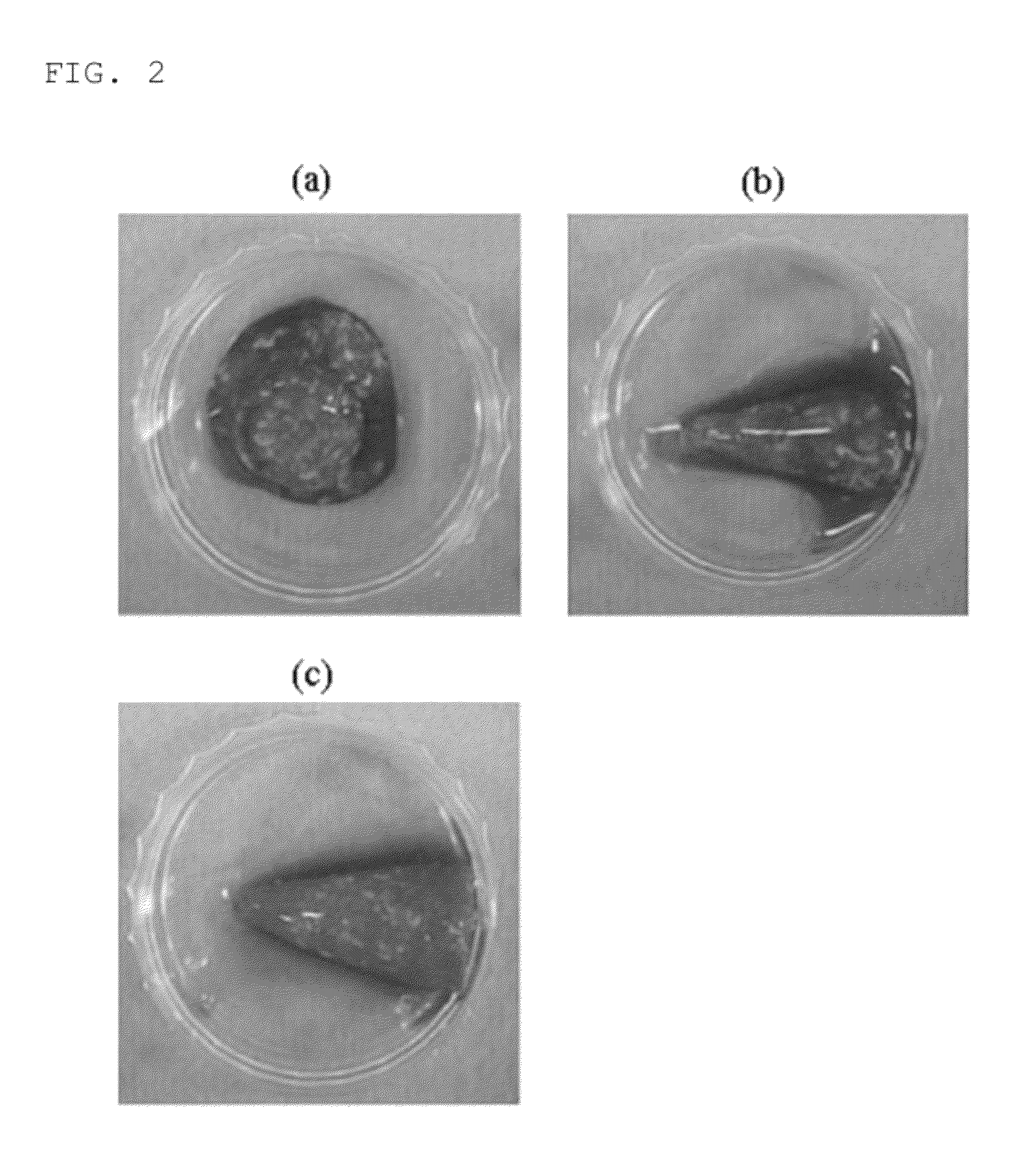Composition for inducing tissue regeneration by activating platelet-rich plasma (PRP)
a technology of activated platelet-rich plasma and tissue regeneration, which is applied in the direction of drugs, peptide/protein ingredients, prosthesis, etc., can solve the problems of inability to neglect development, difficult to inject prp into wounds, and loss of surrounding tissues, so as to improve immune response, eliminate clinical rejection, and convenient and fast separation
- Summary
- Abstract
- Description
- Claims
- Application Information
AI Technical Summary
Benefits of technology
Problems solved by technology
Method used
Image
Examples
example 1
[0047]First, a kit for PRP separation is prepared as below.
[0048]1) A vacuum test tube containing 3.2% sodium citrate
[0049]2) A vacuum test tube holder
[0050]3) A vacuum test tube needle
[0051]4) A vacuum test tube (Plain type)
[0052]5) A 3 mL syringe
[0053]6) A blunt needle
[0054]From the components as mentioned above, a PRP separation method can be deduced. First,
[0055]1) From a patient, 10 mL of whole blood is collected into a vacuum test tube containing 3.2% sodium citrate.
[0056]2) The whole blood charged in the vacuum test tube is centrifuged (1,750˜1,900 g) for 3 to 5 minutes. Herein, the gravity acceleration and the time of the centrifugal separator are set to be optimum levels for separating the whole blood into hemocytes, buffy coat, and plasma.
[0057]3) After the cap of the vacuum test tube is opened, a supernatant liquid (plasma layer) including buffy coat is collected and transferred to a new vacuum test tube (plain type) by using a syringe provided with a blunt needle.
[0058]4...
example 2
[0063]A kit for transplanting a mixture of PRP, a calcium chloride solution, and type I collagen is prepared as below.
[0064]1) 1 mL, 3 mL syringes
[0065]2) A Connecta (three-way connector)
[0066]2) A calcium chloride solution
[0067]3) 20˜50 mg / mL type I collagen
[0068]From the components as mentioned above, a method of transplanting the mixture of the PRP, the calcium chloride solution, and the type I collagen can be deduced. First,
[0069]1) A syringe charged with 1 mL of PRP is connected to a syringe charged with a calcium chloride solution with a concentration of 0.30˜0.55 mg / mL through a Connecta, and the materials are mixed once.
[0070]In other words, FIG. 2 shows photographs of 1 mL of PRP separated from whole blood in a mixture with a calcium chloride solution and type I collagen, in which in FIG. 2(a), the calcium chloride solution is included in an amount of 0.25 mg / mL, in FIG. 2(b), the calcium chloride solution is included in an amount of 0.3 mg / mL, and in FIG. 2(c), the calcium...
example 3
[0075]1) A mixture the PRP, a calcium chloride solution and type I collagen, charged in a syringe, is charged into a round-bottom glass tube.
[0076]2) The mixture is cultured in a 37° incubator for 15 minutes, and clotted. Herein, through the culturing of the mixture in the 37° incubator, it is possible to achieve the same condition as that where the mixture is transplanted into a tissue region and clotted.
[0077]3) The clotted mixture is placed in a sterilized 24-well culture vessel added with 1 mL of DMEM, and cultured in a 37° incubator.
[0078]Through the above described method, 10 mL of whole blood is collected from a patient and is subjected to two centrifugation steps to obtain 1 mL of concentrated PRP. The PRP is firstly mixed with a calcium chloride solution, and secondly mixed with type I collagen. Then, the mixture is transplanted into all regions in need of tissue regeneration in cases such as bone defect treatment and wound healing. In this method, there is no clinical reje...
PUM
| Property | Measurement | Unit |
|---|---|---|
| concentration | aaaaa | aaaaa |
| concentration | aaaaa | aaaaa |
| volume | aaaaa | aaaaa |
Abstract
Description
Claims
Application Information
 Login to View More
Login to View More - R&D
- Intellectual Property
- Life Sciences
- Materials
- Tech Scout
- Unparalleled Data Quality
- Higher Quality Content
- 60% Fewer Hallucinations
Browse by: Latest US Patents, China's latest patents, Technical Efficacy Thesaurus, Application Domain, Technology Topic, Popular Technical Reports.
© 2025 PatSnap. All rights reserved.Legal|Privacy policy|Modern Slavery Act Transparency Statement|Sitemap|About US| Contact US: help@patsnap.com



